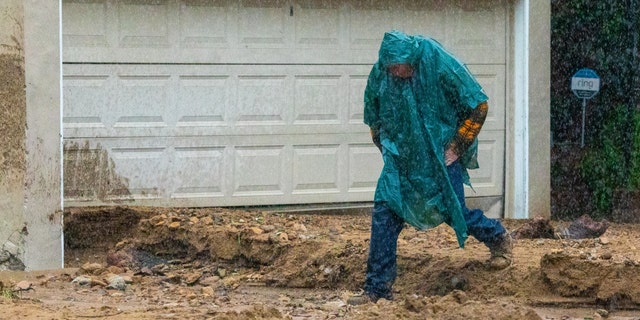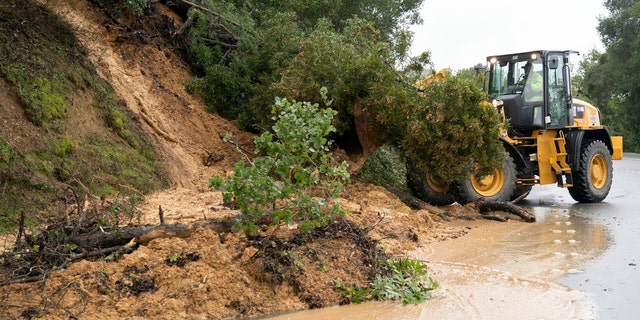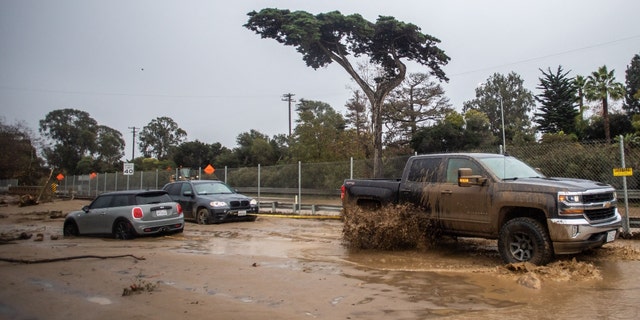California weather: How long could mudslides continue?
Extreme weather threats in California were forecast to continue through the weekend and into next week, bringing even more flooding and wind advisories.
Thus far, the continuous onslaught of storms has forced evacuations, flooded homes, breached levees, sent vehicles into sinkholes, caused road and highway closures, knocked out power, stymied traffic and damaged infrastructure.
In addition, at least 19 people have died since the end of last year, up and down the state.
Gov. Gavin Newsom, who visited Montecito on Friday, is pleading with residents to remain alert amid hazardous conditions.
CALIFORNIA MAN NARROWLY ESCAPES DEATH BY FALLING BOULDER
“I know how fatigued you all are,” he said. “Just maintain a little more vigilance over the course of the next weekend.”
The upscale Santa Barbara County area had been evacuated earlier in the week on the fifth-year anniversary of a mudslide that killed 23 people and destroyed more than 100 homes.
Ed Carroll, the Director of State and Local Government at Tomorrow.io, told Fox News Digital, that he had looked at data sets and determined that the western weather pattern was not likely to go away quickly.
Tomorrow.io helps to mitigate risk prior to events coming in, allowing officials and localities to better understand a weather system and how to respond to it.
“Well, I looked at our data sets and this overall weather pattern for what’s happening, not only in California but in the Pacific Northwest, is probably going to hang around for another week,” he said.

Why do impacts like mudslides continue to affect communities, and for how long can Californians expect them?
“The challenge right now with the mudslide situation is there’s often a lag to that,” the meteorologist explained. “And, what I mean is that they’ve gone through this long period of drought, right? . . . It’s almost like how a really dry sponge doesn’t take on water as quickly as a damp sponge, if you will. So, when it rains, you start to get some compromising to the soil. There’s a lot of runoff initially . . . But, what’s happening out there right now is it’s now beginning to seep into what was sort of a dry environment. And so, now things will start to settle. “
“So that’s what really, in my estimation, causes these mudslides. Because they just don’t typically see these types of rain events,” Caroll added. “It’s just uncommon for them. And, the topography can’t handle it.”

A mega-drought has long plagued the West, but the Golden State has seen some relief over the past couple of weeks.
The latest update from the U.S. Drought Monitor shows that there is no exceptional drought, and just 0.32% was reported to be in a period of extreme drought.
NEVADA’S HIGHWAY 208 TO CLOSE FOR MONTHS AFTER HEAVY RAIN TRIGGERS HUGE LANDSLIDE
A once largely red and purple map was shown to be mostly orange and yellow, although much of the state is still enduring drought conditions.
The Los Angeles Times, citing one of the monitor’s authors, said that it marked the first time that’s happened since April 4, 2020, when none of the state was classified in those categories.

The Centers for Disease Control and Prevention notes that debris flows – or mudslides – are a common type of fast-moving landslide that tend to flow in channels.
They are caused by disturbances in the natural stability of a slope and can follow such droughts and accompany heavy rains, earthquakes or volcanic eruptions.
“Mudslides develop when water rapidly accumulates in the ground and results in a surge of water-saturated rock, earth, and debris. Mudslides usually start on steep slopes and can be activated by natural disasters. Areas where wildfires or human modification of the land have destroyed vegetation on slopes are particularly vulnerable to landslides during and after heavy rains,” the agency notes.
In the U.S., landslides and debris flows result in 25 to 50 deaths annually.

Some areas are more likely to experience landslides or mudflows, including places where wildfires have destroyed vegetation, where landslides have occurred before, at the bottom of slopes or canyons, channels along a stream or river and areas where surface runoff is directed.
After a landslide or debris flow, people should stay away from the site, as flooding or additional slides may occur after such an event.
Carroll highlighted that mudslides are difficult to forecast and can happen at any time, advising people to always refer to local emergency management.
“In the short term, I don’t foresee an end to this because even after the storms tend to wind down, there’s always a period of time afterward where — they literally call it a lag. It’s almost like when a hurricane comes up along the Gulf Coast and you get flooding, but then when the storm passes away, the flooding gets worse, right? Like, a day or so after, because the Mississippi starts to flow. So, everything’s always connected. So, there’s going to be a period of time where it will be a threat, I would foresee, for weeks to come versus just like a week or two,” he continued.
“You know, and you do have these storms that bring wind with them. But, when you bring wind and rain at the same time, which is just a monster for them — that’s what’s really causing most of the coastal erosion that’s going to be taking place over the next several weeks, if not months, based on the fact that could be, you know, other landslides would come in the wake of something like this,” Carroll said.
On Monday, President Biden issued an emergency declaration to support response and relief efforts, but the governor is still waiting on the administration to issue a major disaster declaration.
Damage assessments, which have already started, are expected to surpass $1 billion.
The Associated Press contributed to this report.
Read the full article Here


